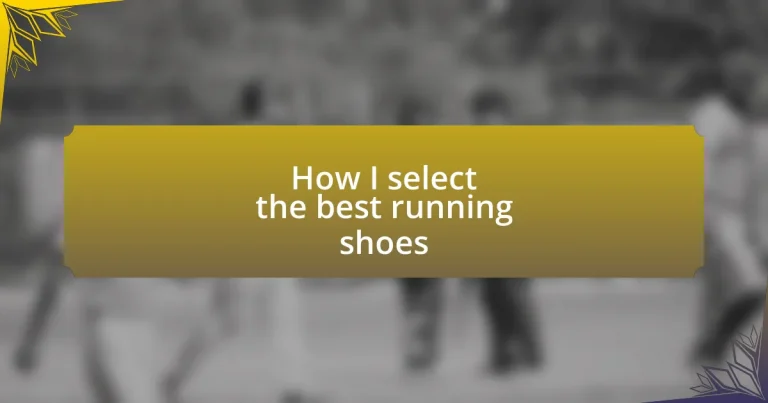Key takeaways:
- Understanding your foot type (neutral, pronated, or supinated) is crucial for selecting suitable running shoes.
- Analyze your running style (heel, midfoot, or forefoot striker) and choose shoes accordingly for enhanced comfort and performance.
- Assess the terrain you run on, as different surfaces require specific shoe features like grip, cushioning, and support.
- Always try on shoes with your running socks and test them for an extended time to ensure proper fit and comfort.
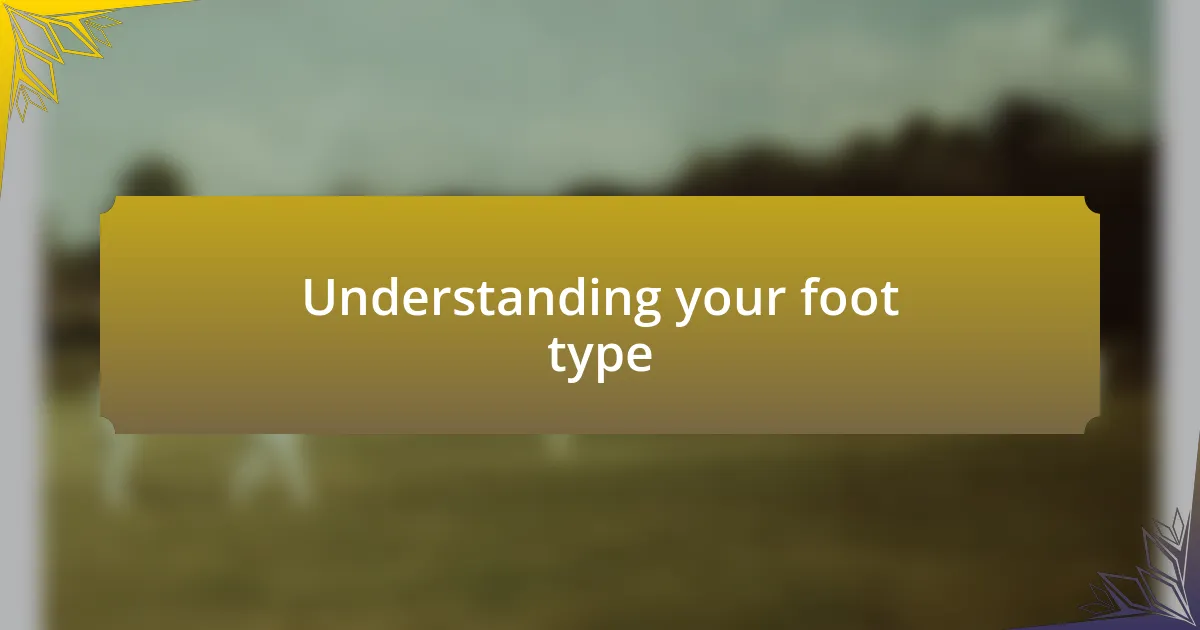
Understanding your foot type
Understanding your foot type is essential for selecting the best running shoes. I vividly remember my first serious attempt at running; I purchased a pair of shoes that looked great but didn’t suit my feet at all. Within weeks, I felt discomfort and even pain, leading me to wonder: why was I struggling while my friends seemed to run effortlessly?
There are three main foot types: neutral, pronated, and supinated. Knowing which category you fall into can make a huge difference in your running experience. Personally, I discovered that I have a neutral foot type after many trips to various shoe stores and the help of knowledgeable staff. They used a simple test involving wet feet to show my arch type. Can you imagine the relief I felt learning that my discomfort stemmed from choosing the wrong shoe rather than my running ability?
Once I understood my foot type, selecting the right shoe became less of a guessing game and more about finding what truly supported me. I began to appreciate how different shoe features cater to different foot mechanics. It feels liberating to run in a shoe that feels like a natural extension of my foot rather than a constraint. Have you ever experienced that feeling? That’s the kind of comfort and confidence every runner deserves!
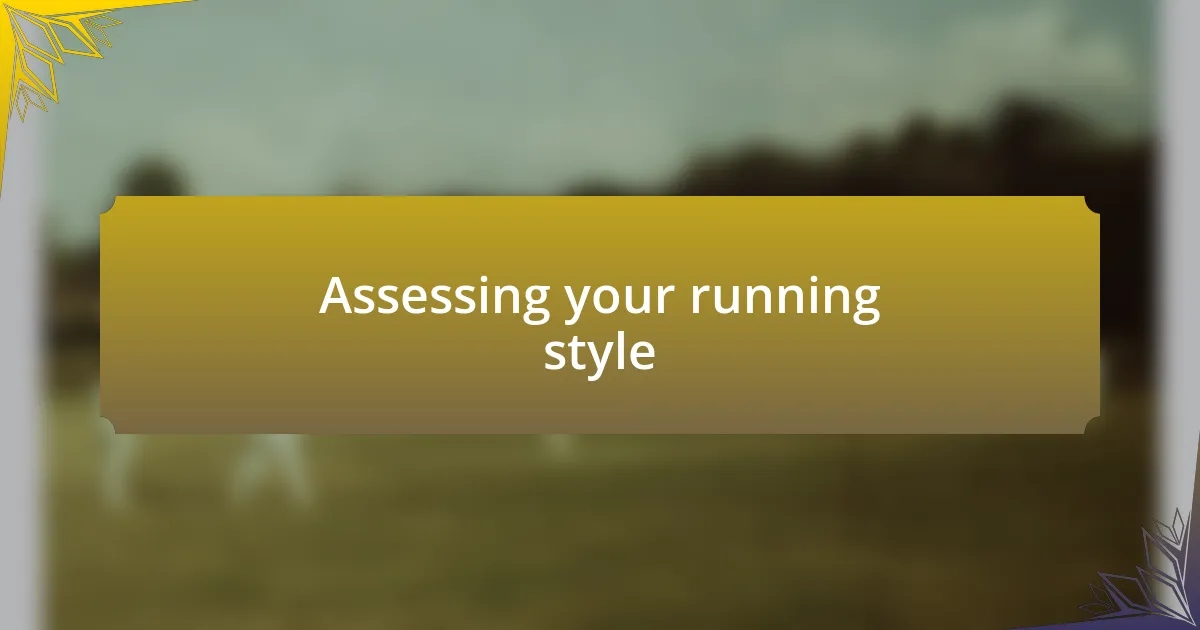
Assessing your running style
Assessing your running style is a critical step toward finding the right shoes for your unique needs. Personally, I’ve noticed that my running gait changes depending on fatigue and the terrain. Observing how your foot strikes the ground can provide invaluable insights into which type of cushioning and support you need. Have you ever paid attention to how your foot lands? It can really affect your overall comfort and performance.
Taking the time to analyze your stride can reveal if you’re a heel striker, midfoot striker, or forefoot striker. For me, watching videos of my runs made a significant impact. I was stunned to see how I naturally strike with my midfoot, which explained my preference for shoes with more flexibility and less cushioning. A great tip is to find a running buddy or use a camera to capture your form so you can make informed decisions based on real data.
To help you better understand how running styles differ, I’ve put together a comparison table of the three primary strike types. It illustrates the characteristics and recommended shoe types for each style. This guide can serve as a starting point for anyone looking to fine-tune their shoe selection process.
| Running Style | Characteristics | Recommended Shoe Type |
|---|---|---|
| Heel Striker | Foot lands on the heel first, often with a longer stride. | Extra cushioning and heel support. |
| Midfoot Striker | Foot lands in the middle, creating a balanced motion. | Neutral shoes with moderate cushioning. |
| Forefoot Striker | Foot lands on the ball of the foot, leading to a shorter stride. | Lightweight shoes with less cushioning for agility. |

Identifying your running terrain
Understanding the terrain where you run is just as important as analyzing your running style. I remember when I first began exploring different paths; running on a gravel trail felt completely different than the smooth pavement of the city streets. Acknowledging whether you’re hitting the trails, road, or a track can help narrow down the shoe selection significantly. Each type of surface requires distinct features in footwear, such as grip and support, that can enhance your running experience.
Here’s a quick breakdown of common terrains and what to consider:
- Paved Roads: Look for shoes with lightweight cushioning and good responsiveness, as these surfaces typically have less impact.
- Trails and Dirt Paths: Prioritize shoes with rugged traction and stability to handle uneven surfaces and prevent slips.
- Treadmills: Choose shoes similar to road running models, focusing on comfort and breathability, as the surface is generally forgiving.
- Tracks: Shoes designed for speed and performance are ideal, often lightweight with minimal cushioning to allow for quick strides.
- Sand or Soft Surfaces: These require shoes with supportive structures to help maintain stability and prevent foot fatigue.
Identifying the terrain can shape not just your shoe choice but your overall running experience. Making these considerations has often transformed my runs into something much more enjoyable and less taxing on my body.
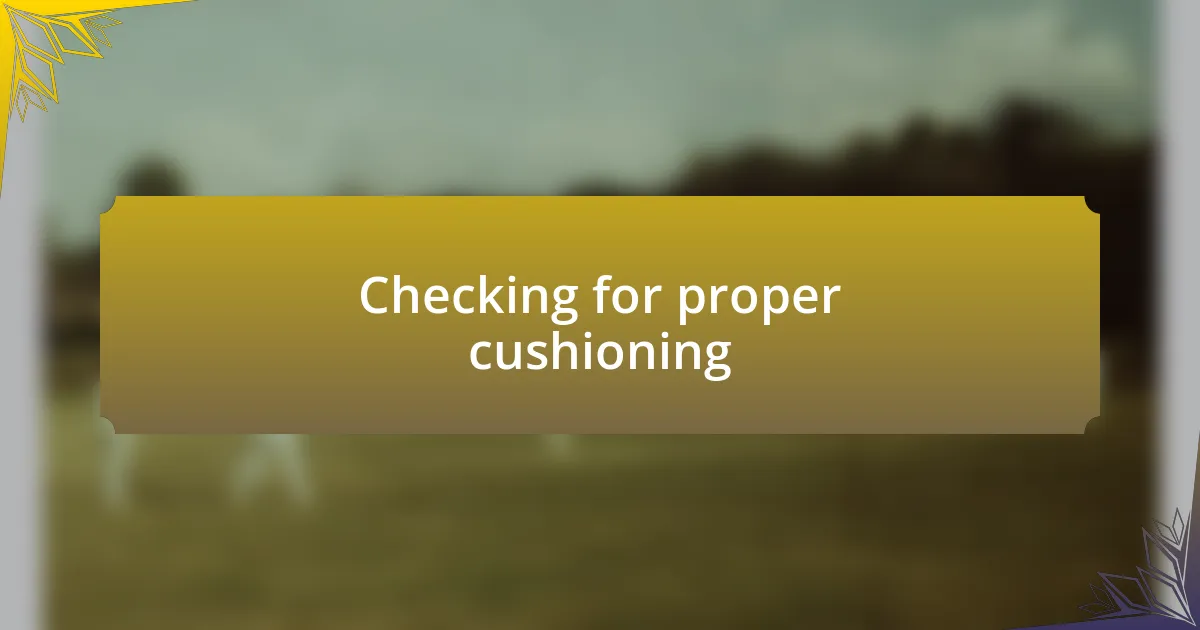
Checking for proper cushioning
When selecting running shoes, proper cushioning is pivotal. I vividly recall my first long-distance race; the wrong shoes left my feet aching by mile ten. Cushioned shoes can absorb impact and reduce fatigue, making them essential for comfort, especially on hard surfaces. Have you ever felt that blissful bounce when your foot strikes just right? That’s the magic of well-cushioned footwear.
As I explore different models, I always test the cushioning by applying pressure with my hand. It’s fascinating how this simple act can reveal the shoe’s responsiveness. I generally look for a blend of softness and support—too much cushioning can lead to instability, while too little can leave my joints screaming after a few miles. Finding that sweet spot is key.
In my experience, different types of cushioning materials can significantly influence how a shoe feels. For instance, I once tried a brand that used gel cushioning, and the difference was night and day during a 10K race; I felt as if I were gliding above the pavement. Each runner’s preference is unique, so I encourage you to take the time to experience various options. What works for one person may not work for another, but that’s the beauty of the journey in finding your perfect pair.
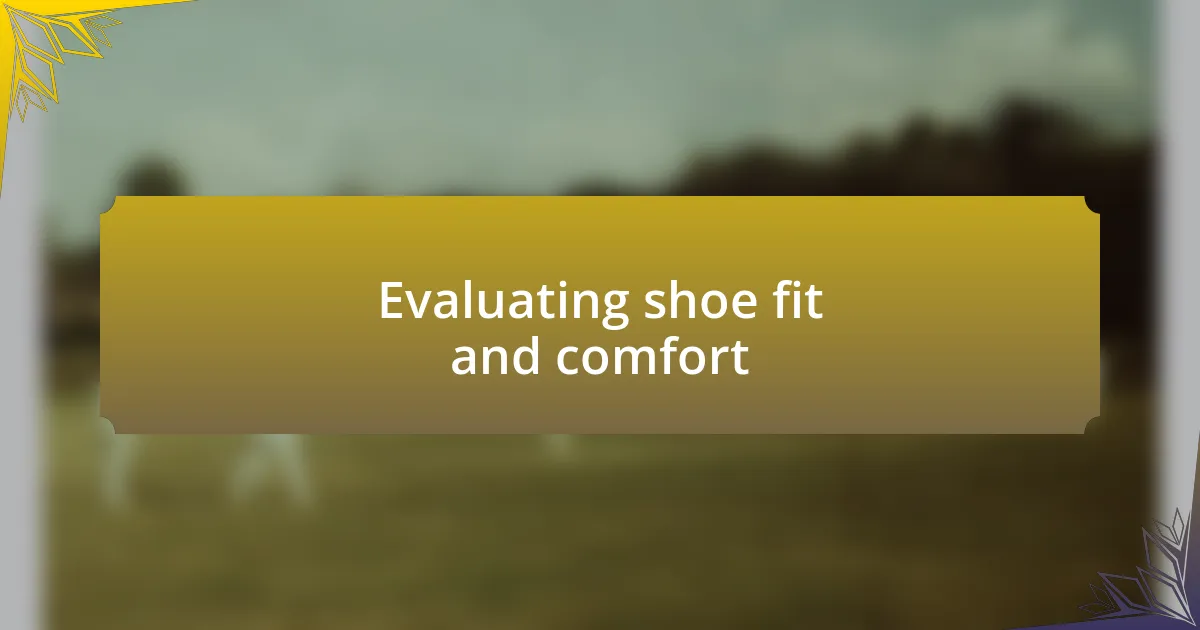
Evaluating shoe fit and comfort
Finding the right fit in running shoes is like discovering the perfect partner for a dance; it should feel natural and enjoyable. I remember when I first tried on a pair that felt snug yet liberating. It was as if my foot was cradled just right, allowing me to move effortlessly. How often have you tried on shoes that feel great at first, only to realize they pinch in the wrong spots after a few minutes? I’ve been there, and it taught me to always walk around a bit before making a decision.
When assessing comfort, I pay attention to the toe box and heel cup. A shoe should feel secure without squeezing, allowing my toes to wiggle freely. One time, I was convinced to buy an appealing pair that looked fantastic but had a toe box that felt restrictive. After just a couple of runs, I regretted that impulse buy. It’s vital to ensure your shoes have enough room, as crowding can lead to blisters and discomfort. Isn’t it amazing how something as simple as fit can transform your running experience?
Another thing I’ve learned is to consider the sock situation. I prefer wearing the socks I would normally run in while trying on shoes, which often changes how they feel. On one occasion, I switched to a thicker pair and realized my go-to size was actually too tight. This was an “aha!” moment for me; the right socks can enhance the overall comfort and fit. Have you considered how your socks impact shoe comfort? Trust me—paying attention to these details makes a world of difference in your running journey.
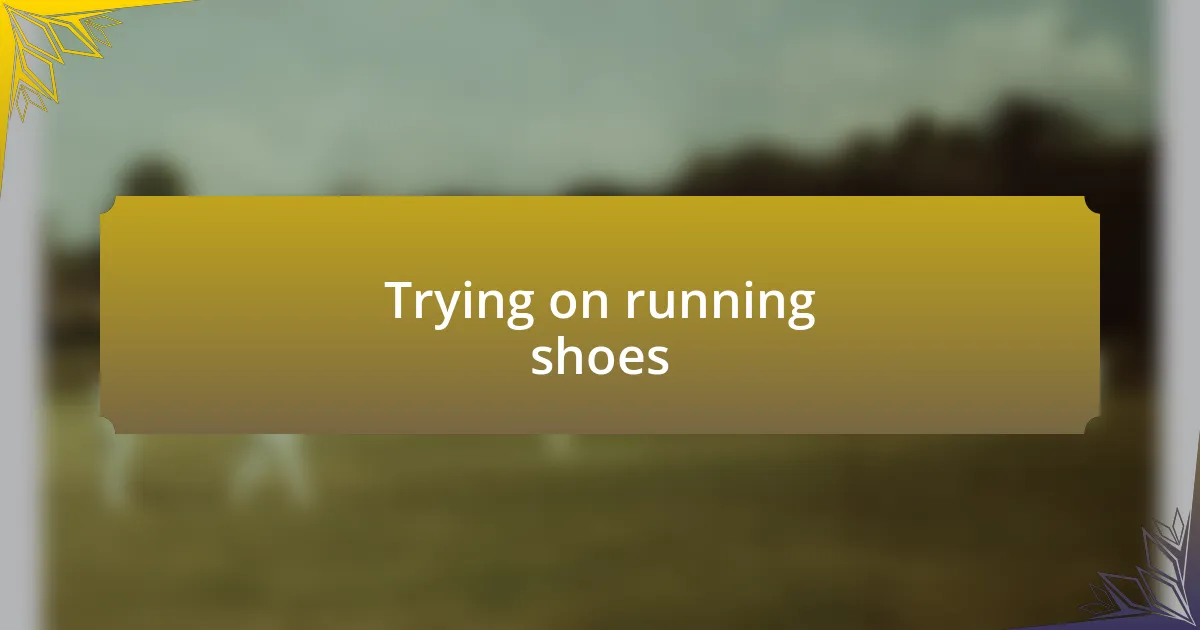
Trying on running shoes
When I step into a shoe store, trying on running shoes feels like embarking on a mini-adventure. I recall a particularly memorable visit, when I slipped on a pair that seemed to hum with potential. The moment I laced them up, I felt a spark of excitement as if I could already envision my next run in those shoes. How often do you feel that tingle of anticipation when trying on new gear? It’s a mix of hope and curiosity, knowing that the right shoe could elevate my running experience.
As I walk around the shop, each step becomes an important test. I always look for how the shoe reacts—does it bounce back with responsive support, or does it feel flat? One time, I found a shoe that looked great but felt like a lifeless brick with each stride. That day taught me that visuals can be deceiving; what matters most is how they feel in action. How often do we overlook this simple yet crucial step? It’s not just about aesthetics; the true worth of a running shoe reveals itself when we take those first steps.
One thing I cannot stress enough is the importance of trying them on for longer, at least ten minutes. I remember losing track of time during one fitting, immersed in that moment of testing. Eventually, I noticed a hot spot developing on my arch—a red flag I wouldn’t have caught on initial wear. Have you ever experienced discomfort that only surfaced after a while? Taking extra time can prevent a disappointing purchase and help ensure your choice supports you on many runs to come.

Making an informed purchase decision
Making an informed decision when purchasing running shoes is crucial. I remember the time I found myself overwhelmed by the sheer number of options, each claiming to be the best. It was a bit daunting, but I realized that asking the right questions helped clear the fog. What features matter most – cushioning, support, or durability? Narrowing down my priorities transformed the shopping experience from chaotic to focused.
Before making a final decision, I often do a bit of research about the brand and the technology behind certain models. I recall browsing reviews online and even reaching out to fellow runners in my community for their opinions. Their insights often provided that extra layer of confidence in my choice. Have you ever noticed how collective wisdom can shine a light on details you might have missed?
Finally, I never underestimate the power of a trial run. A few times, I purchased shoes only to discover they weren’t quite right after my first run. It’s an unpleasant surprise, much like arriving at the office only to find you forgot an essential piece of paperwork. Testing shoes outside, on a pavement or trail, gives you a genuine feel for how they perform. It’s a step I encourage everyone not to skip; your feet deserve that extra diligence.
